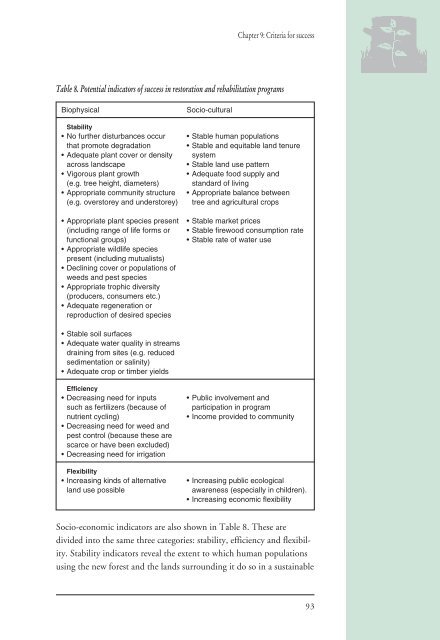Rehabilitation and Restoration Of Degraded Forests (PDF) - IUCN
Rehabilitation and Restoration Of Degraded Forests (PDF) - IUCN
Rehabilitation and Restoration Of Degraded Forests (PDF) - IUCN
You also want an ePaper? Increase the reach of your titles
YUMPU automatically turns print PDFs into web optimized ePapers that Google loves.
Chapter 9: Criteria for success<br />
Table 8. Potential indicators of success in restoration <strong>and</strong> rehabilitation programs<br />
Biophysical Socio-cultural<br />
Stability<br />
• No further disturbances occur • Stable human populations<br />
that promote degradation • Stable <strong>and</strong> equitable l<strong>and</strong> tenure<br />
• Adequate plant cover or density system<br />
across l<strong>and</strong>scape • Stable l<strong>and</strong> use pattern<br />
• Vigorous plant growth • Adequate food supply <strong>and</strong><br />
(e.g. tree height, diameters) st<strong>and</strong>ard of living<br />
• Appropriate community structure • Appropriate balance between<br />
(e.g. overstorey <strong>and</strong> understorey) tree <strong>and</strong> agricultural crops<br />
• Appropriate plant species present • Stable market prices<br />
(including range of life forms or • Stable firewood consumption rate<br />
functional groups) • Stable rate of water use<br />
• Appropriate wildlife species<br />
present (including mutualists)<br />
• Declining cover or populations of<br />
weeds <strong>and</strong> pest species<br />
• Appropriate trophic diversity<br />
(producers, consumers etc.)<br />
• Adequate regeneration or<br />
reproduction of desired species<br />
• Stable soil surfaces<br />
• Adequate water quality in streams<br />
draining from sites (e.g. reduced<br />
sedimentation or salinity)<br />
• Adequate crop or timber yields<br />
Efficiency<br />
• Decreasing need for inputs • Public involvement <strong>and</strong><br />
such as fertilizers (because of participation in program<br />
nutrient cycling) • Income provided to community<br />
• Decreasing need for weed <strong>and</strong><br />
pest control (because these are<br />
scarce or have been excluded)<br />
• Decreasing need for irrigation<br />
Flexibility<br />
• Increasing kinds of alternative • Increasing public ecological<br />
l<strong>and</strong> use possible awareness (especially in children).<br />
• Increasing economic flexibility<br />
Socio-economic indicators are also shown in Table 8. These are<br />
divided into the same three categories: stability, efficiency <strong>and</strong> flexibility.<br />
Stability indicators reveal the extent to which human populations<br />
using the new forest <strong>and</strong> the l<strong>and</strong>s surrounding it do so in a sustainable<br />
93

















